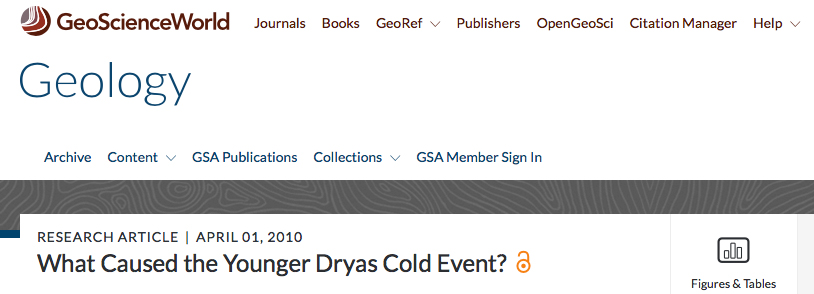The Greenland Impact Craters~ by Phil Webb
What happens when Partridge Island hits Greenland at 10 kilometers/sec?
Carl Sagan said that the Solar System is a “Shooting Gallery”. What he meant is there are large numbers of physical objects such as small asteroids and comets moving through it traveling at more or less 10 kilometers/sec and occasionally they strike planets, moons and each other.
In 2018 it was officially confirmed that the 30 km (19 mile) wide depression under the Hiawatha Glacier in Greenland was in fact the result of an impact from a large meteor striking the earth.
Now, a second possible impact crater may have been discovered only 184 km (114 miles) from the Hiawatha Crater. This depression is 35 km (22 miles) wide, and has yet to be dated and confirmed.
You can read Phil’s pdf presentation here (or click the pic above).
Further Links to the Greenland Impact Craters~
 This is the first time that a crater of any size has been found under one of Earth’s continental ice sheets. The researchers worked for last three years to verify their discovery, initially made in the 2015 …more.
This is the first time that a crater of any size has been found under one of Earth’s continental ice sheets. The researchers worked for last three years to verify their discovery, initially made in the 2015 …more.
 “I began asking myself ‘Is this another impact crater? Do the underlying data support that idea?’,” MacGregor said. “Helping identify one large impact crater beneath the ice was already very exciting, but now it looked like there could be two of them” …more.
“I began asking myself ‘Is this another impact crater? Do the underlying data support that idea?’,” MacGregor said. “Helping identify one large impact crater beneath the ice was already very exciting, but now it looked like there could be two of them” …more.
The Younger Dryas Cold Event~ by Matt West
The Younger Dryas cold period lasted for 1500 years and occurred at the end of the last ice age.
This cold period happened at a time when global temperatures were rising after the Pleistocene ice age and the glaciers were melting and retreating. For 1500 years the world suddenly returned to ice age conditions.
The dominant theory for why this occurred is the introduction of cold, fresh meltwater into the North Atlantic that rerouted the Gulf Stream and shut down heat flow from the tropics.
An alternate theory is “nuclear winter” caused by a meteor impact. While there is evidence for a layer of iridium in sediments of an age corresponding to the start of the Younger Dryas, my feeling is that this is a coincidence.
A new impact crater has been found in Greenland that some suggest might be the right age to be the source of the iridium layer; however, this crater has not yet been dated, so we must wait and see.
The reason that most scientists favour the meltwater hypothesis over the impact hypothesis is the duration of the cold climate. A “nuclear winter” is only expected to last for a few years, but the Younger Dryas lasted 1500, and it’s timing correlates well with changes to ocean sediments in the North Atlantic that indicate the presence of cold, fresh water.
A meteor impact might have been the “smoking gun” for the extinction of megafauna, such as the Wooly Mammoth, that occurred during the Younger Dryas, but it is not likely to be the cause of the Younger Dryas.
Thanks to Phil Webb for talking about meteor impacts and the new Greenland impact craters, and for inviting me to talk about the Younger Dryas cold period. You can view my pdf presentation here or click the pic above.
Further Links to Younger Dryas event~
 The Younger Dryas is one of the most well known examples of abrupt change. About 14,500 years ago, Earth’s climate began to shift from a cold glacial world to a warmer interglacial state. Partway through this transition, temperatures…read more.
The Younger Dryas is one of the most well known examples of abrupt change. About 14,500 years ago, Earth’s climate began to shift from a cold glacial world to a warmer interglacial state. Partway through this transition, temperatures…read more.
 The Younger Dryas Cold Event has long been viewed as the canonical abrupt climate event. The North Atlantic region cooled during this interval with a weakening of Northern Hemisphere monsoon strength. The reduction in northward heat…read more.
The Younger Dryas Cold Event has long been viewed as the canonical abrupt climate event. The North Atlantic region cooled during this interval with a weakening of Northern Hemisphere monsoon strength. The reduction in northward heat…read more.
In March 2019 Phil Webb and Matt West of the Saint John Astronomy Club gave joint presentations on Impact Craters and the Younger Dyras Cold Event. This was at the Saint John Astronomy Club monthly meeting in Saint John. The SJAC meets the first Saturday of every month (holidays excepted) at the Rockwood Park Intrepretation Centre. You can see more presentations like this and gain valuable and interesting information at these meetings.
All are welcome–no experience necessary.


